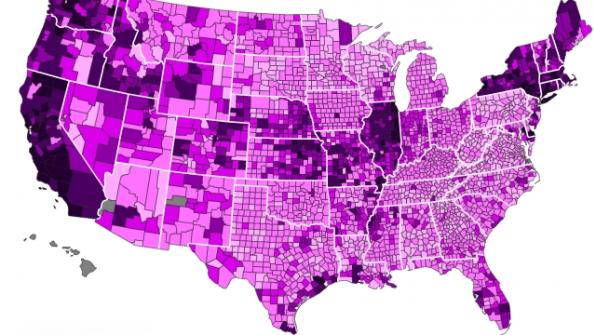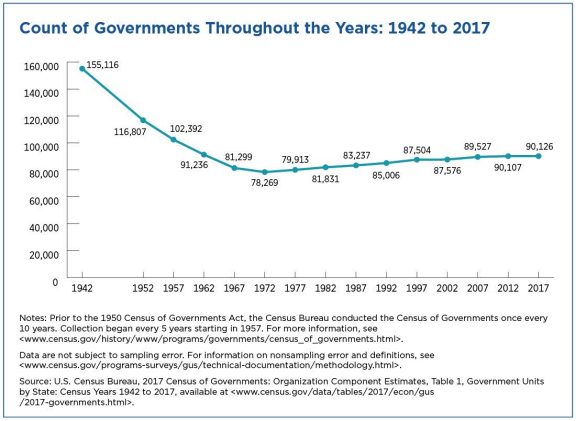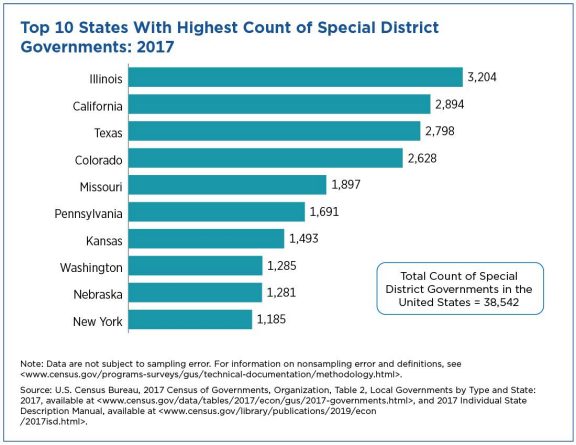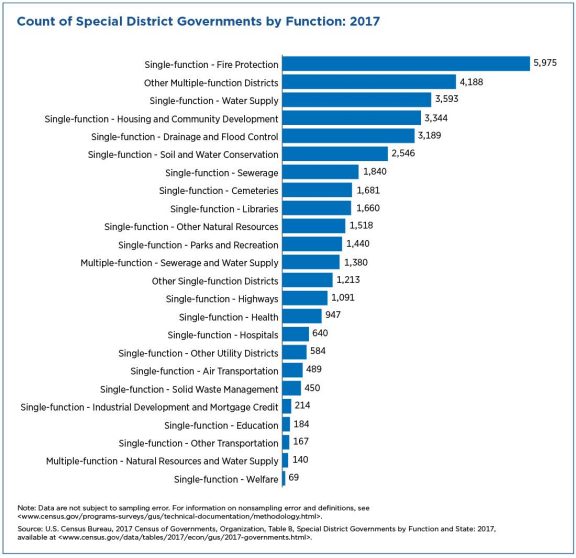
From Municipalities to Special Districts, Official Count of Every Type of Local Government is in the 2017 Census of Governments.
We know what counties and municipalities are. But what are special districts?
Special districts are independent government units created for a limited, specific purpose and, every year, new districts are created and existing ones dissolve.
The latest in-depth, encyclopedic count of special districts and all types of local governments in the United States is now available.
Released earlier this year, the U.S. Census Bureau’s 2017 Census of Governments Organization component provides statistics on governments in the United States as of June 2017 and shows changes since the last count in 2012.
Tables show counts by government type, state, population-size groups, function and school systems.

Local governments are classified into five types: county, municipal, township, special districts and school districts.
County, municipal and township governments are general-purpose governments. The official count for those types of governments has not changed significantly since 2012.
Then there are special districts.
They typically have a shorter lifespan and higher turnover than general purpose governments, but the difference in their counts was also relatively slim between 2012 and 2017: The 2017 Census of Governments added more than 1,500 special districts and removed roughly 1,260 that are no longer operating.
Nebraska Examples of Special Districts
Airport Authorities, Cemetery Districts, Community Building Districts, County Fair Boards, Drainage Districts, Hospital Districts and Authorities, Housing Agencies, Interstate County Bridge Commissions, Irrigation Districts, Joint Electric Power, Sewerage and Solid Waste Disposal, Water Distribution Agencies—1981 Law, Joint Public Power Authorities—1982 Law, Metropolitan Transit Authority, Metropolitan Utilities Districts, Natural Resources Districts, Public Power Districts, Reclamation Districts, Risk Management Pools, Road and Street Improvement Districts—1957 and 1961 Laws, Rural and Suburban Fire Protection Districts, Rural Water Districts, and Sanitary and Improvement Districts.
Why So Many New Special Districts?
So why are states creating special districts these days?
In some cases, states create them to provide services to newly- developed geographic areas.
In other cases, the special purpose activity or services already exist, but residents expect a higher level of quality.
For example, a state may have fire protection services. However, the established governmental structure may not legally allow the fire district to raise enough funds to maintain the desired level of quality services.
That’s when a state may choose to create a special district. Most special districts can levy additional property or sales taxes, and may borrow money to buy or build facilities by issuing bonds.
Some districts are only active for a limited time, usually as long as it takes to pay back a debt.

Multifunction Districts
Between the 2012 and 2017 census, multifunction districts grew the most.
Multifunction districts can collect property taxes and issue tax-exempt bonds. Legislation authorizing multifunction districts was passed in most states across the nation in the 1980s.
For example:
- In Colorado, the 2017 Census of Governments added close to 270 metropolitan districts to the master list of local governments in the state.
Metropolitan districts can provide a wide array of services, such as fire protection, street improvements, recreation, mosquito control and television relay services.
These districts can collect property taxes and issue public debt. That’s why it’s important to keep track of public funds controlled by these districts.
Most of the metropolitan districts in Colorado are development districts created to provide funding for development projects.
- In Texas, multifunction districts, called Municipal Utility Districts (MUDs), also showed growth. The 2017 Census of Governments added nearly 200 units to the master list of local governments in Texas.
MUDs provide a variety of utility services in areas not included in a municipality. These districts can finance developing infrastructure and housing.
MUDs can incur public debts in the form of bonds to finance infrastructure and/or housing, and may dissolve in 15 to 25 years after the debt is paid in full.
As in Colorado, developers who see public-private partnerships as business opportunities usually drive the creation of multifunction districts.

Development And Water Supply Districts
Financing capital improvement was the leading force behind special district growth in Florida.
The 2017 Census of Governments added about 130 new Community Development Districts (CDD). In Florida, CDDs may finance a variety of community development projects, such as new sewage facilities.
The 2017 Individual State Descriptions publication provides a comprehensive description of the governmental organization for the 50 states and the District of Columbia.
Some of these districts are similar to Community Improvement Associations (CIAs) in size and scale of operations. Both are a result of the housing boom from 2003 to 2008.
The major difference is that CDDs are considered public government units that enjoy some tax exemptions, although this comes with other regulations and required transparency in governing these districts.
The 2017 Census of Governments data also reflect the creation of more water supply districts in New Mexico. Over 150 Mutual Domestic Water Consumers Associations were included as special district governments since the last census. Other states, including California, Arkansas, Missouri and Washington, also added between 10 to 20 water supply districts.
Fire And Emergency Services Districts
Nationally, Emergency Services Districts (ESD) that provide local fire protection and ambulance services have grown this decade: 150 were created from 2012 to 2017 — 130 of them in Texas.
The increase is centered in areas experiencing the fastest population growth in the country since the 2010 Census.
Often, ESDs are organized as a funding tool for existing volunteer fire departments. These allow volunteer fire districts to collect additional property and sales taxes to provide service to their expanding communities.
It can be challenging to find fire-fighting funding in areas losing population and experiencing declining property values.
In Arizona, for example, laws passed in 2013 allow fire districts to consolidate into fire authorities to reduce overhead costs. The 2017 Census of Governments shows 14 new joint fire authorities in Ohio.
Some township volunteer fire departments have recently begun to combine personnel, equipment and property tax revenue to become official special district governments.
Another way districts can improve emergency response and rescue operations is by creating Emergency Communications (911) Districts to help coordinate resources between municipalities, counties and other local governments.
Some states, including Texas, Iowa, and Oregon, have had them since 1985. Others like Washington and Massachusetts have recently introduced laws enabling citizens to create 911 districts.
Download the Individual State Descriptions: 2017 Census of Governments

